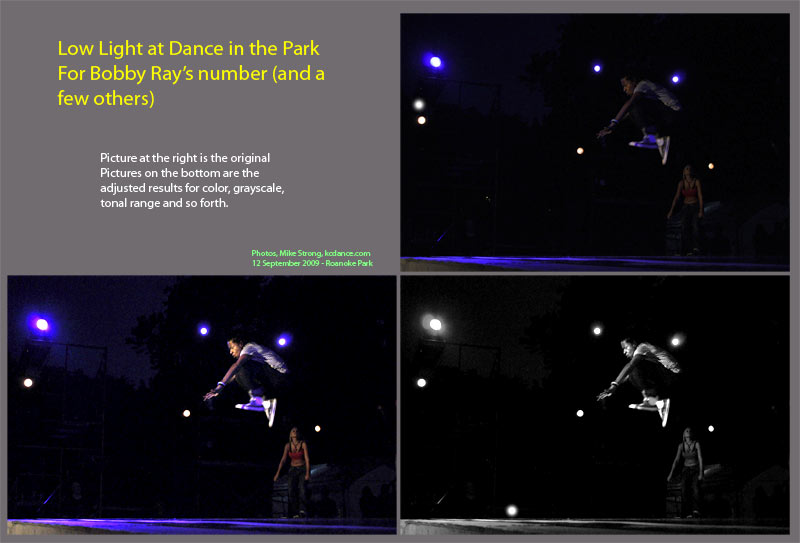Lighting For Multiple Use
Stage Presentation, Video, Photo, Publicity, Promo, CV, Bio, History, Archives, Unforseen Future Needs
Over the years I've come to realize that the photographs and videos of individual dancers and of company performances will sooner or later be requested for any number of purposes. Often, especially when requesting photographs for publication or publicity, the request is for high-quality pictures which can be reproduced in large sizes.
When the photographs were shot in lousy light, they fall apart when they are too large. This is one of the reasons you see so many studio shots, done with full studio strobes and repeating a handful of movements until the shot is finally acheived. In performance, or in dress, you don't get to keep repeating a handful of movements until you get a good quality shot.
So, either you set up a separate studio or production session (on stage with strobes or special lighting in lieu of going to a photographer's studio). That takes time, usually planning well ahead, extra money for the photo shoot and when you are done, it still may not look as dynamic as action taken in the middle of dress or performance.
Live shooting is also much less predictable because you have to be ready to get the shot and it may only come once or twice within a piece. Performance shots mean a larger number of exposures compared to the number you will eventually pick. Studio work limits the number of shots because you know the pose or poses you want (for a poster, ad or program) and you just repeat the pose or poses until you have the shots.
I used to think that was just the way it was. I thought of myself as someone on the side who needed to get shots while basically remaining out of the way and not overly conspicuous. Whatever condition existed I would just have to work within it. I've shot in environments which were too dark for my camera/film combinations right from the beginning, since the summer of 1967. Sometimes I even think of myself as a specialist shooting in too-dark-for-the-camera rooms.
The photographer and the videographer are normally considered last in the food chain, if accomodated at all, and then seldom is the light designed with photography/videography in mind. That leaves you with these choices:
1 - Just accept the poor technical results
2 - Set up a separate session just to shoot for the record, for the archives, for publicity with totally different light
3 - Light from the start so that you can get technically high-quality photos as you perform
It is one thing if the only person wanting these pictures is the person shooting and if they have no real purpose for either the company or the individual dancers. In that case the shooter will indeed just have to put up with conditions and get what photographs they can. In practice, I've been asked for publicity-usable, CV-usable, news-usable, archive quality work, after the original shoot. At that point you can't go back and change conditions or shoot for certain persons and certain spots in the production.
Either you got it or you didn't. With good shooting conditions you have it. When the original shooting conditions were not good enough (usually very bad), either the pictures or video could not be used, especially to send out for resumes and promotional material or they just didn't exist at all because the performance was simply un-shootable. All because the lighting conditions were not set right, from the beginning.
Live theater is something you view in the moment, but the archive will sustain you into the future, or even offer opportunities for continued revenue. A prime example here is New York's Metropolitan Opera which not only broadcasts their live shows the week after but also streams the shows over the internet for fees (single use and subscription plans) and The Met sells the videos on disk.
So The Met not only gets revenue from ticket sales, The Met also gets future revenue from after sales of the recorded performances. If they don't have a decent recording, they don't have those downstream revenues. They put a lot of money into recording their performances and it doesn't just go to the archive and sit there. They use it.
One of the first photography lessons I learned was that everything had to be in place, and set correctly on the camera for the intended use, before I ever pressed the shutter button. That meant I had to have the exposure (film, f/stop, shutter speed), focus, framing and expected chemical development process, printing method and intended display environment in mind before pressing that button on the camera. Once the button was pressed the chemical development, the printing, the print size, the print density/contrast, printing paper and the light for the display space all followed. Each dependent on the previous step.
- Would the picture be shown on a halftone page or an art exhibit space?
- Is this for reproduction (high quality) or just a buddy shot.
- Would this be a major-size enlargement?
- Small camera or large,
- fine-grain and low ASA (ISO) or
- high-speed film with more grain expected.
- Exposure controlled density and development controlled contrast on the negative.
- Kodalk (Kodak's trademark for a weak alkalie) bath or stop bath or water and then stop bath or two-stage development (hard and soft developers, maybe a pyrogallol type )
- fine grain developer or medium with a different tonal scale developer, developer, package mix or one of my from-scratch developers
- print on eggshell white with blue-black or neutral black or warm-black or use a print toner
- hard paper or soft and
- would this be in a bright room or dark hallway.
All of those considerations would be part of the calculation when determining the camera settings - - - before pressing the shutter button. If you don't get it right from the beginning everything which comes after is fixing. And it will look fixed, like a repair job. But if you get it correct from the start it looks like a poster, or an exhibit print.
Setting up light for a video production
On a movie set the DP (director of photography) has dictatorial powers over everyone. There is a good reason. The cameras are the entire production. Every audience will see through the cameras, not with their own eyes watching performers on stage. If something is wrong, it is wrong in the film or video forever. It doesn't disappear after a few night's run. So, everything has to be right for the camera. The DP is totally on the spot. If it isn't right the DP takes the hit.
The same thing on a video set where the intention is to go to DVD or to television broadcast. Everything must be lit for the camera. If, after spending that much money for the cameras, your DP is not insisting that the stage is lit for camera (i.e. lit for the sake of the money you are spending), then you need another DP. The DP is not being a prima-donna shooter. The DP is making sure your money isn't wasted - when all is said and too far done to redo.
- Setup a television and connect it to your video camera
- You will set your lights according to how it looks through your camera on the television
- Start with the brightest set, evenly lit from wing to wing with all lights filtered for 5600k
- Setting this for daylight (5600K) is what digital cameras are designed for.
- Changing the white balance to something else, such as tungsten, requires un-even amplification (boost) of one or more color channels to compensate.
- That in turn causes digital noise - grain-like globbing in the image. Most commonly in the blue channel.
- Set up a single exposure setting on the camera which will work for this bright set
- Manually set the white balance. Because you've already set the lights to 5600K this should be a small tweak
- Getting the color balance right, from the start, saves you all kinds of correction problems later, including an image which looks pretty messed up.
- Never change the exposure on the camera.
- From then on, all dark or light is a matter of stage-light changes
- This way you are never chasing the lighting, which is really a way of defeating lighting
- Make sure all light changes are evaluated on a television monitor hooked to the camera.
- The darkest dark on the stage is whatever looks dark on the television. Not what looks dark to your eyes.
- Your eyes are constantly adjusting and compensating for brightness changes.
- So adjusting by eye, rather than TV monitor, will be misleading
Always light with the camera in mind. You may think you can get by now and the photographers will just have to put up with conditions or maybe you don't want to put up a fuss. But that isn't the deal. You will want results later and if you don't set lights now which are usable by cameras you won't be able to fix them later. They will be like those sand pantings which are destroyed when done. Gone. Poof! Followed by, "Oh, crappppp."
So let me say again: On a stage production the camera is usually the last consideration, if considered at all. Until later. That is when you run into trouble because you want to show other companies what you did - maybe you are selling them on your choreography to get them to produce your piece, or maybe you are looking for a job as a dancer with them, or maybe you want something for YouTube because you see that as free advertising.
Whatever you want pictures for now (or maybe you were not thinking of this), I can tell you from experience, you will want to go back later and use pictures and video you had from earlier. So, you should be in the habit of setting things up so that your future picture and video needs will be possible.
The most important single ingredient in getting successful, usable-in-the-future photos and videos is having enough light, and at the right color temperature.
- The Photos and Video you are able to record now will be needed in the future.
- If you don't light for camera: ...
- you will pay a lot later to do them in a studio or
- you will have to re-create them for additional money/time or
- you will miss opportunities for
- grant application material
- funding requests
- publicity
- news stories
- resumes as a dancer or teacher including tenure reviews
- promotional materials
- advertising
- re-create lighting for a new performance
- re-construct choreography for new performance or another company
- attract students (if you are a school) who will judge their selection partly on photos of you
- DVD sales - either for perfomers and families
- DVD sales for professional reproduction sales (where contracts allow for commercial sale)
- and just a lot more
- The lighting designer should also take these multiple uses into account
- patrons who don't see as well in the dark (usually older)
- funders - often those same older patrons (believe me when I say I've heard grumbling from the same folks)
- photographers and videographers covering your stage production
Good Lighting - KCBLighting in the pictures below is by Kirk Bookman. Next time at KCB, look to see how he lights. When I see him there I am always reassured, knowing I will be able to shoot good video or stills. I know that I can set the camera for a daylight white balance (avoiding a lot of digital noise which otherwise crops up mostly in the blue channel), that the stage will be evenly lit avoiding hot spots, that specials won't blow out highlights and that the audience will not even notice that the stage lighting is also good for camera. For the shots below I was able to shoot at
It is important to remember that low light is not moody it is just low.
Starting with a lot of light gives you a wide range of tonal scales you can use. |
||
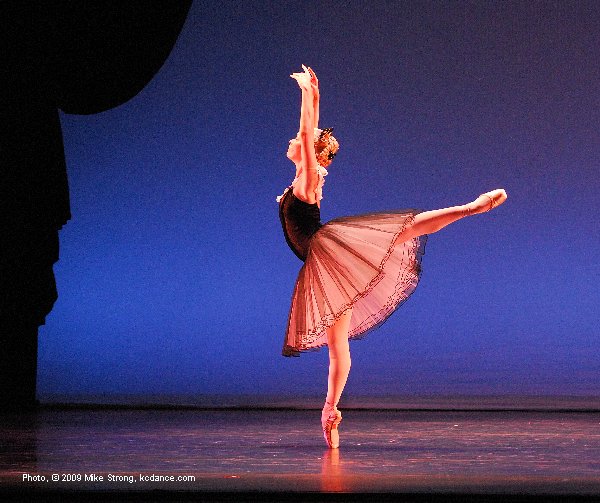 |
||
 |
||
 |
||
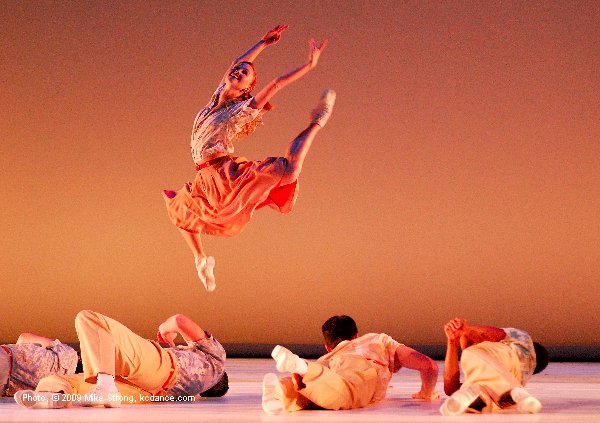 |
||
Take a good look. Kirk's lighting (above) is copious, even across the stage, without hot spots or drop offs, doesn't bring attention to itself, yet it does illuminate the production. Very pretty lighting.
|
Frankly, I bellyache about lighting. Over the years it seems to me that stage light has gotten progessively worse, a small amount at a time, just sort of drifting downward, darker by a quarter-stop, or a half-stop a year. I kept wondering whether it was just me but then I've been shooting with more and more capable equipment (able to shoot in darker climes) and more expensive equipment just to keep up. However, I haven't been sure whether it was just my faulty recollection. This time I have at least one visual comparison.
Bad to Miserable Lighting for Camera
To be fair, some of the worst lighting has given me some of my best shots. Below are a few of those shots. The shooting was miserable because I have to always be aware not only of what is happening in the dance but also when they are in a location where I can use the light. For as much as I am talking about the need for good light, what a photographer does is to find what light there may be in front of your face.
If, as a photographer, I just want some picture from anywhere in the production this doesn't really matter. Newspapers may run one shot only. But if this is your production and you want pictures from all of it or from somewhere which is your favorite part or something on which you really wanted good shots, it may not be available if the pictures couldn't be taken or if when taken they were not viewable.
| At the 30th Anniversary of El Grupo Folklorico Atotonilco |
 |
| Lighting comes from early-version LED lights on poles at the front corners of the platform stage. That lead to extreme hot spots as any performer approaced the downstage corners (note the blown highlights in the dress and on the girl just behind). Not to mention the wierd spectrum from this generation of LED stage lights. They really mess up the way the filters in a digital camera records color. |
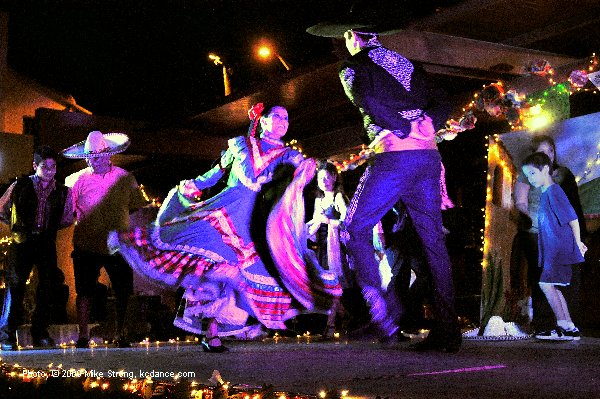 |
 |
What it can look like 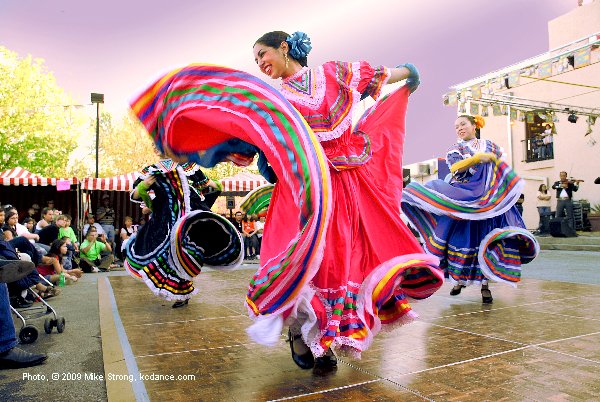 Cinco de Mayo 2008 at Guadalupe Center - actual daylight, unusual for me. But the colors are rich, the detail is sharp and most of the shots are usable even if I don't select them all. I can easily move to different spots and expect good exposure conditions. This is a good shot for publicity, posters, promotional material, although not planned for that purpose. |
| Olé Flamenco |
Olé Flamenco at KC Fringe 2007 - The lighting was nothing but a few badly placed parabolics, creating mostly hotspot lighting. I had to shoot as people moved into the hot spots. The lighting works out as dramatic, though not by intention. |
| Downtown nightclub |
Some neat looking pictures, but tough to shoot anyway. In this case you just have to position yourself for the fiew lights and wait until people move into them and they are all on at the same time |
